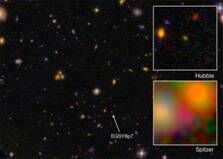
After the Big Bang created the universe 13.8 billion years ago, scientists believe the first galaxies began to form half a billion to 1 billion years later. Finding such galaxies has been a challenge because their light is so faint, which makes the discovery of a 13.2 billion-year-old galaxy -- the farthest known -- especially intriguing to scientists.
The galaxy, called EGS8p7, was pinpointed as an area for further investigation after scientists evaluated data from the Hubble and Spitzer space telescopes. A team of Caltech researchers then performed a spectrographic analysis of the galaxy, a process used to measure its red shift, which is used to determine the distance a galaxy is from Earth.
In theory, scientists shouldn't have been able to see a galaxy this old because neutral hydrogen atoms were believed to have absorbed radiation from newly formed galaxies, making the older galaxies incredibly faint and virtually undetectable, according to the study published in the Astrophysical Journal Letters.
While scientists aren't certain why they are able to see this galaxy, one theory is that hydrogen reionization during the early beginnings of the universe may have been patchy, explaining why some galaxies are more visible than others.
It's also possible EGS8p7 may be housing hot stars that, in turn, create a giant hydrogen bubble, allowing the galaxy to be seen.
"The galaxy we have observed, EGS8p7, which is unusually luminous, may be powered by a population of unusually hot stars, and it may have special properties that enabled it to create a large bubble of ionized hydrogen much earlier than is possible for more typical galaxies at these times," Sirio Belli, one of the Caltech researchers who worked on the project, said in a statement.
The researchers said they are now taking a closer look at the exact chances of finding this galaxy in order to gain an understanding of whether the timeline of reionization in the early universe needs to be revised.
本时文内容由奇速英语国际教育研究院原创编写,禁止复制和任何商业用途,版权所有,侵权必究!
1.What is scientists’ explanation about the discovery of EGS8p7?
A Hydrogen reionization in the early universe may have been patchy.
B There are some hot stars in Galaxy EGS8p7, which create a giant hydrogen bubble.
C Scientists are not certain why EGS8p7 is visible.
D Both A and B.
解析:选D。细节综合题。根据文章第4段one theory … 和第五段 It’s also possible …可知,对于发现EGS8p7星系,科学家有两种解释。
2.What conclusion can be drawn by the scientists from the discovery of EGS8p7?
A Spectrographic analysis of the galaxy should be improved in order to discover new galaxies.
B The Big Bang theory about the creation of the universe may be totally wrong.
C The present theory about the early universe might be revised.
D The discovery of EGS8p7 is probably wrong.
解析:选C。推理判断题。根据文章最后1段可知,早期宇宙形成的再离子化进程表需要修正,而这正是宇宙形成理论的一部分。